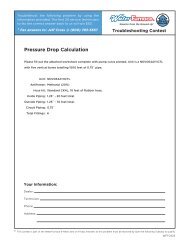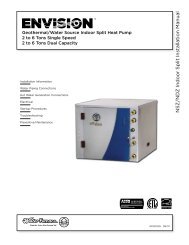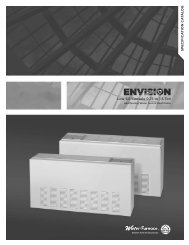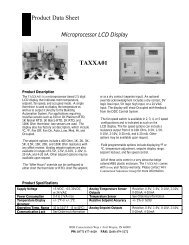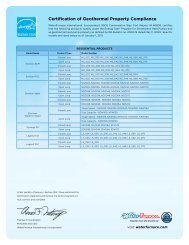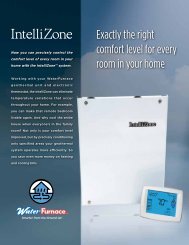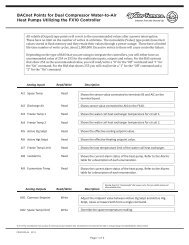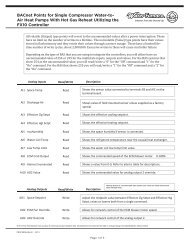Sound Application Guide: - WaterFurnace
Sound Application Guide: - WaterFurnace
Sound Application Guide: - WaterFurnace
You also want an ePaper? Increase the reach of your titles
YUMPU automatically turns print PDFs into web optimized ePapers that Google loves.
SOUND APPLICATION GUIDE: DESCRIPTION AND RATINGS<br />
Rating Methods cont.<br />
Single Number Ratings cont.<br />
Noise Criterion Method – NC Curves<br />
The NC method has been used for more than 40 years.<br />
Although it is a single number rating, it is more sensitive to<br />
relative loudness and speech interference of a given noise<br />
spectrum. It is popular primarily because of its wide use<br />
in acoustic design textbooks. A noise curve is corrected<br />
for transmission loss through the ceiling ASHRAE 2003<br />
HVAC <strong>Application</strong>s 47.33. The resulting noise curve is then<br />
plotted on a chart of NC curves (every 5 dB). The highest<br />
interpolated NC curve (in 1 dB increment) attained is the NC<br />
rating. Figure 4 shows an example with an NC-36 rating.<br />
Figure 4: NC Performance results in an NC-36 Rating<br />
<br />
<br />
<br />
<br />
<br />
<br />
<br />
<br />
<br />
<br />
<br />
<br />
<br />
<br />
<br />
<br />
<br />
<br />
<br />
<br />
<br />
<br />
<br />
<br />
<br />
<br />
<br />
Balanced Noise Criteria (NCB)<br />
The NCB method was designed as a successor method<br />
to the NC Curve. The NCB features higher permissible<br />
upper frequencies, two low frequency octave bands, and<br />
an additional test for rumble and hiss compliance. By<br />
averaging the NCB levels for frequencies 500, 1k, 2k, and<br />
4k, the overall NCB rating is obtained.<br />
Figure 5: NCB Performance results in an NCB-25 rating with<br />
rumble imbalance.<br />
<br />
<br />
<br />
<br />
<br />
<br />
The method also allows for a descriptor for low frequency<br />
rumble or high frequency hiss imbalance. If frequencies<br />
below 1 kHz are more than 3 dB higher than the NCB rating<br />
curve, it is rumble imbalanced. If frequencies above 1 kHz<br />
are more than the best fit level of the 125, 250 and 500 Hz<br />
NCB rating curve, the NCB rating curve is hiss imbalanced.<br />
The figure below results in an NCB 25 with low frequency<br />
rumble imbalance.<br />
<br />
<br />
<br />
<br />
<br />
<br />
<br />
<br />
<br />
<br />
<br />
<br />
<br />
<br />
<br />
<br />
<br />
<br />
<br />
<br />
<br />
<br />
<br />
<br />
7



